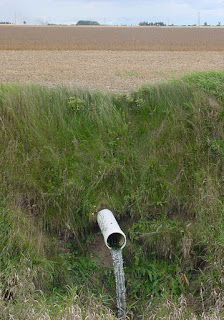stock image
IN EARLY YOUTH, on drives with my father through the Northern Iowa countryside, I would marvel at wild ducks in small wetland plots on farms. [Later I learned that the upper half of Iowa was primarily a pothole prairie ecosystem, with “potholes” or wetlands being the result of leveling and scooping by the Des Moines Lobe of the last ice age.]
By high school, there were no wetland plots. Most of the land had been rapidly tiled and water was diverted into drainage ditches, and those ditches were different from creeks/small streams. They were truly “ditches” in the sense of being very steep—much lower than the surface of fields rather than a gradual grade typical of creeks, with a narrow water channel that was largely straight running like a pipeline. Fields ran to the edge of the ditch and roads. There was no attempt to create hedgerows as in Europe or grass strips along streams. In fact, legislative efforts were regularly opposed and defeated.
stock images
Note how the tile outlets are below any potential field buffer strip. A wetland would have to be contrived where the bottom of the ditch is and, with a significant rainfall event, would overwhelm and wash through the wetland as this ditch serves many fields.
Standing at the south side of the Iowa State Capitol building, you can almost see where the Des Moines Lobe stopped. Driving north from Des Moines, the vista of the landscape in Northern Iowa is essentially that of a tabletop--an agricultural design that is nearly seamless except for roadways and thin fencerows.
This flat surface and sub-surface tile design results in rapid displacement of water and soil and a loss of artificial nutrients used in agricultural production. It accelerates soil erosion and diminishes and degrades the massive underlying aquifer that are problems getting less attention than more visible degradation of surface water quality.
In response to criticism of diminishing water quality, agricultural interests argue that they recognize the problem and have made substantial improvements. Accordingly, there should already be some positive impact on water quality. The rationale for current higher nitrate readings is a sense that seasonal conditions as the culprit.
Such a rationale is erroneous, and likely hopes that other issues such as soil erosion and aquifer damage will remain only a whisper and not build to outrage. For soil erosion, observe the rapid silting of all artificial bodies of water.
There are no potholes, wetlands, or prairies or prairie surrogates to absorb and optimize the water quality and soil bank. This industrialized agriculture simply cannot claim to steward the land when it takes every inch and plumbs the land.
Years ago, I was invited to give a talk in Fort Dodge on the Brushy Creek project that created a small artificial lake. It was very apparent that nothing could sway economic development. This is what dominates and drives decision-making. Now the lake is rapidly silting in from the flow of all of the drainage ditches north of the lake and a quite wild Brushy Creek is lost. These decisions increase agricultural costs as well and decrease economic benefits by becoming less attractive for recreation.
In Des Moines, along the Raccoon River, it might be a housing development on land that flows into the river rather than a recreational lake as was the case some years past.
Having gone to small streams, rivers and prairie remnants in Central and Northern Iowa across the years, I have some long-term sense of the quality of these unsettled landscapes.
In 1989, I published River Eternal with Viking that was largely descriptive of a landscape just south of Fort Dodge along the Des Moines River. I have published essays on prairies and on the adaptive features of urban ecology.
I have lived in Des Moines now for perhaps 35 years. As a nature writer, I have spent much time alongside the Raccoon River in all of its seasons. In August, in many years, through various weather cycles, I would go to the Raccoon River and “stream-walk” when the river tended to be low. It would involve wearing a swimsuit and T-shirt and aqua-shoes and walking and floating in the river. For the past few years, the water has taken a remarkable negative turn. It is clearly polluted with nutrient producing a green algal bloom and I have not gone stream-walking. While a summer season might be so droughty as to not “flush” the river and therefore increase the level of nutrients in the water, it is evident that there is an annual high nutrient constancy if not an increase now each year.
It is obvious that the situation has deteriorated rather than improved. And this degradation is statewide on rivers and lakes, urban and rural areas.
Environmental degradation in the forms of 1) nitrates in water (and nitrites, phosphates, chloride, and changes in pH and dissolved oxygen) but also (2) soil loss and (3) continued stress on the vast aquifer impact directly on farmers/farming. Water issues in 1989 in the United States were thought to reference problems in the Western United States [See Marc Reisner, Cadillac Desert: The American West and Its Disappearing Water]. Now, in 2016, there is a growing public awareness of water issues, both fresh and oceanic, as global. And these environmental problems now are global human health issues and no longer "out there."



No comments:
Post a Comment